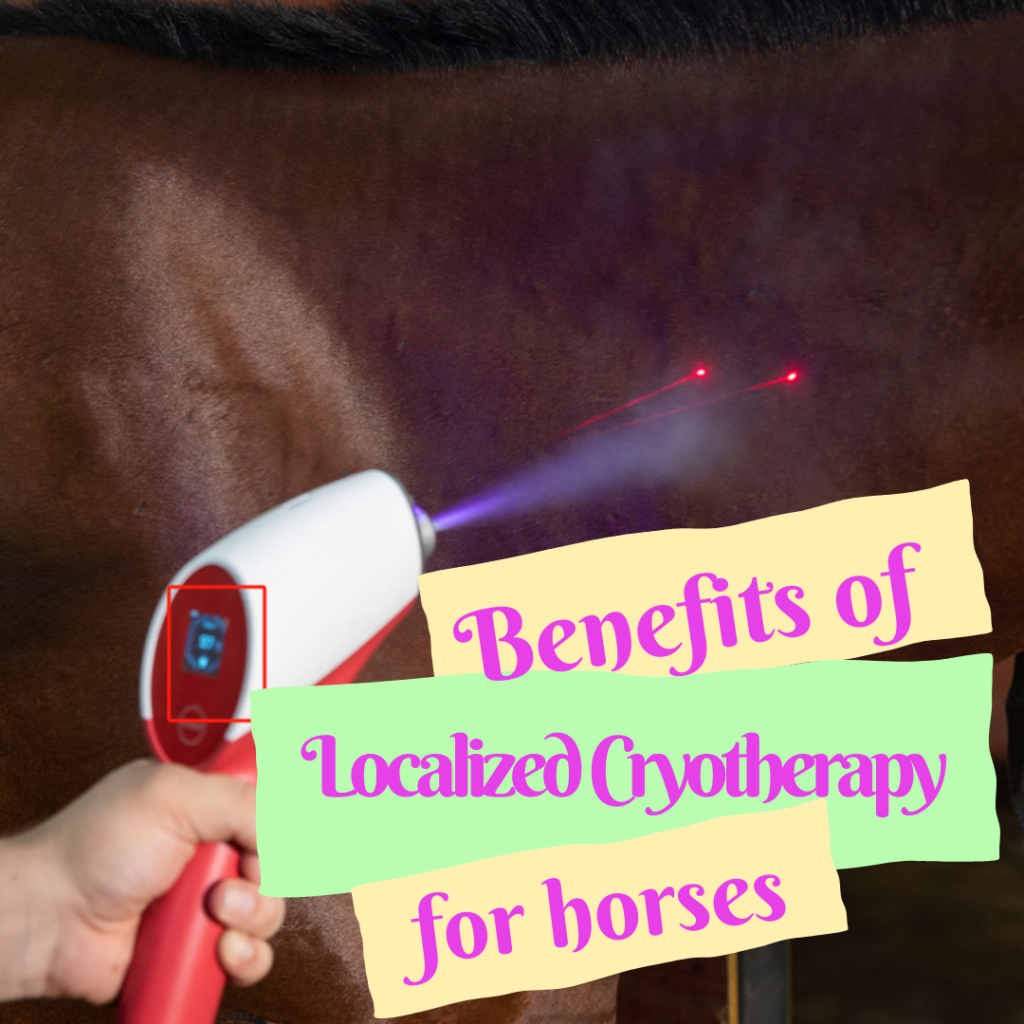
Localized cryotherapy is an innovative and effective modality that has been gaining traction in equine care. This hyper-targeted approach to cold therapy offers a host of benefits for horses, from managing acute injuries to enhancing performance recovery. It’s easy to understand why QHE Healing is so excited to offer cryotherapy to our clients – This technique is quickly becoming a staple in equine rehabilitation and wellness programs. As a fascia specialist, it is my mission to offer the best options for fascial health. I am very impressed by what localized cryotherapy can accomplish in a very short period of time.
What is Localized Cryotherapy?
Localized cryotherapy involves the application of extremely cold temperatures to specific areas of the body. Effective use of this technique with a cryotherapy gun, requires specialized training to ensure safety and optimal results. Unlike traditional cold therapy methods such as ice packs or cold hosing, localized cryotherapy uses advanced equipment to deliver consistent and precise cooling. This allows for deeper penetration into tissues and more controlled treatment sessions, resulting in faster and more effective outcomes, making it an excellent addition to the QHE menu of services.
The Science Behind Cryotherapy
Cold therapy works by inducing vasoconstriction—the narrowing of blood vessels—which helps to reduce inflammation and swelling. When the cold stimulus is removed, the blood vessels dilate, increasing circulation to the area and promoting the delivery of oxygen and nutrients essential for tissue repair. Additionally, cryotherapy can decrease nerve sensitivity, providing pain relief and enabling greater comfort for the horse during recovery.
Key Benefits of Localized Cryotherapy for Horses
1. Reduction of inflammation and Swelling
Inflammation is a natural response to injury or strain, but excessive inflammation can hinder recovery. Localized cryotherapy effectively reduces swelling and helps manage inflammatory conditions such as tendonitis, joint inflammation, and even laminitis.
2. Accelerated Healing
By enhancing blood flow to the treated area, localized cryotherapy accelerates the healing process. Improved circulation brings essential nutrients and oxygen to damaged tissues, facilitating faster healing and reducing downtime for horses.
3. Pain Management
Localized cryotherapy numbs the treated area, providing immediate pain relief. This is particularly beneficial for horses recovering from injuries or those with chronic conditions such as arthritis. Pain relief allows horses to move more comfortably, which is crucial for maintaining mobility and preventing secondary complications.
4. Enhanced Muscle Recovery
After intense training or competition, horses can experience muscle soreness and stiffness. Localized cryotherapy helps to flush out lactic acid and other metabolic waste products, reducing muscle fatigue and promoting faster recovery. This makes it an invaluable tool for equine athletes.
5. Improved Hoof Health
Horses suffering from hoof-related issues, such as abscesses or cracks, can benefit from localized cryotherapy. The targeted cooling helps reduce inflammation within the hoof capsule, alleviating pain and supporting the healing process.
6. Preventative Care
Incorporating localized cryotherapy into a horse’s regular care routine can help prevent injuries by reducing muscle tightness and improving joint flexibility. This is particularly important for performance horses that are subjected to rigorous training schedules.
Practical Applications
Localized cryotherapy can be applied in a variety of ways, depending on the horse’s needs. Common applications include:
- Tendons and Ligaments: To treat tendon strains, suspensory ligament injuries, and other soft tissue conditions.
- Joints: To manage arthritis or post-surgical swelling.
- Hooves: For conditions like laminitis, navicular syndrome, or abscesses.
- Back and Neck: To alleviate soreness and muscle tension in these areas.
Training for Cryotherapy Gun Use
Proper training is essential for anyone administering localized cryotherapy using a cryotherapy gun. A comprehensive training program should include:
- Understanding Equipment: Familiarization with the components and functions of the cryotherapy gun.
- Safety Protocols: Learning how to prevent tissue damage, including recognizing early signs of frostbite or adverse reactions.
- Treatment Techniques: Mastery of application techniques, such as optimal distance, movement patterns, and duration of exposure for various anatomical regions.
- Condition-Specific Applications: Training on tailoring treatments for specific conditions like tendon injuries, joint inflammation, or hoof issues.
- Monitoring and Assessment: Skills to monitor the horse’s response during and after treatment and make necessary adjustments.
- Hands-On Practice: Supervised sessions to build confidence and proficiency in real-world scenarios.
Safety and Best Practices
While localized cryotherapy is generally safe, it should always be administered by a trained professional. Recommended training includes certification programs in cryotherapy techniques, with specific modules on the safe and effective use of cryotherapy guns. Hands-on experience under the supervision of an experienced practitioner is essential to ensure proper application and to minimize risks. Improper use of cold therapy can lead to tissue damage or frostbite. It’s important to follow these guidelines:
- Monitor the Horse’s Reaction: Watch for signs of discomfort or skin irritation.
- Limit Treatment Duration: Sessions typically last between 5 to 15 minutes per area.
- Avoid Open Wounds: Do not apply cryotherapy directly to open sores or wounds without veterinary guidance.
It should be noted that as of 2022, FEI regulations limit the use of localized equine cryotherapy devices to five days prior to an event. Otherwise, it is safe to use daily during rehabilitation and injury recovery. Many equine practitioners and horse owners have reported remarkable improvements in their horses’ recovery times and overall well-being with localized cryotherapy. From competitive show jumpers regaining their edge to retired pasture pets finding relief from chronic pain, the success stories are numerous and inspiring.
Conclusion
Localized cryotherapy is a game-changer in equine care, offering targeted and effective treatment for a range of conditions. Whether you’re managing an acute injury, supporting an aging horse, or seeking to enhance your equine athlete’s performance, this advanced modality has much to offer. By integrating localized cryotherapy into your horse’s wellness plan, you’re investing in their comfort, recovery, and long-term health.